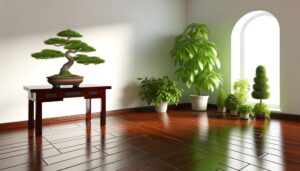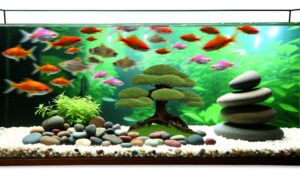What Happens to Bonsai Trees in Low Light?
Most bonsai trees are not suitable for low light conditions. They generally need substantial light to thrive, with an ideal daily exposure of 4-6 hours of direct sunlight.
Inadequate light leads to issues such as etiolation and chlorosis, compromising their health and vigor. Specific species such as Juniperus and Pinus require full sunlight, while others like Ficus prefer indirect but bright light.
Utilizing artificial lighting, such as LED grow lights, can alleviate low light environments, ensuring sufficient spectral quality. Understanding and managing light requirements is vital for maintaining robust bonsai trees.
More details on proper care can greatly enhance your bonsai's growth.

Key Takeaways
- Most bonsai species require substantial light for healthy growth.
- Prolonged low light exposure compromises bonsai tree resilience and health.
- Supplemental LED grow lights are beneficial for indoor bonsai in low light environments.
- Juniperus and Pinus bonsai need full sunlight, while Ficus can thrive in bright indirect light.
- Monitoring light intensity ensures bonsai receive adequate light for photosynthesis.
Understanding Bonsai Light Needs

Understanding the light requirements of bonsai trees is necessary for their best growth and health, as light directly influences photosynthesis and physiological processes.
Photosynthetically Active Radiation (PAR) is essential for converting light energy into chemical energy, which fuels growth and development. Bonsai species typically require a minimum of 4-6 hours of direct sunlight daily to maintain ideal metabolic functions.
Insufficient light can lead to etiolation, chlorosis, and stunted growth. For indoor bonsai, supplemental lighting with full-spectrum fluorescent or LED grow lights can simulate natural sunlight.
Light intensity, duration, and quality must be carefully managed to mimic the tree's native habitat. Understanding these parameters enables enthusiasts to cultivate vibrant, healthy bonsai, ensuring longevity and aesthetic appeal.
Common Bonsai Species
Among the diverse array of bonsai species, commonly cultivated varieties include Juniperus (juniper), Ficus (fig), and Pinus (pine), each with its distinct light requirements and care techniques. Juniperus prefers bright light and well-ventilated areas, thriving in outdoor settings. Ficus, known for its adaptability, can tolerate lower light conditions but benefits from indirect sunlight. Pinus, a sun-loving species, requires full sunlight to maintain its vigor and compact growth. Understanding these species' specific needs is essential for successful cultivation.
| Species | Light Requirement | Care Remarks |
|---|---|---|
| Juniper | Bright, outdoor | Needs good ventilation |
| Ficus | Indirect sunlight | Adaptable, but prefers light |
| Pine | Full sunlight | Essential for growth and health |
Low Light Bonsai Myths

Misconceptions about bonsai trees thriving in low light conditions are pervasive and often lead to suboptimal care practices. Research indicates that most bonsai species require substantial light exposure to maintain their physiological functions and aesthetic form.
This section clarifies these common misunderstandings and provides evidence-based insights into the actual light requirements of bonsai trees.
Common Misconceptions Explained
Frequently, bonsai enthusiasts erroneously believe that these miniature trees can thrive in low light conditions, a myth that often leads to poor plant health and growth. Misunderstandings about bonsai light requirements can result in weakened foliage, stunted development, and increased susceptibility to pests and diseases.
Let's clarify some common misconceptions:
- Indoor Adaptability: Many assume all bonsai species are suited for indoor environments with limited light. In reality, most bonsai trees require substantial sunlight.
- Artificial Lighting: Some believe that basic household lights are sufficient for bonsai. However, these lights lack the intensity and spectrum necessary for photosynthesis.
- Shade Tolerance: While some species can tolerate partial shade, prolonged low light conditions will inevitably compromise their resilience.
Understanding these points is essential for maintaining healthy bonsai trees.
Truth About Light Needs
Although some bonsai species can endure lower light conditions for short periods, the majority require consistent, bright light to sustain ideal growth and health. Research indicates that light intensity directly influences photosynthesis, which is pivotal for nutrient production and overall vitality.
Insufficient light can lead to elongated internodes, weak foliage, and diminished root development. Species such as Ficus and Jade may tolerate lower light but still benefit from periodic exposure to higher light levels.
Optimal light conditions involve placing bonsai near south-facing windows or using grow lights that mimic natural sunlight spectra. Understanding each species' specific photoperiod requirements ensures robust health and enhances the artistry of bonsai cultivation.
Regular monitoring and adjustments are essential for thriving bonsai.
Ideal Indoor Lighting
To achieve the best indoor lighting for bonsai trees, it is important to take into account natural light sources. This includes the strategic placement of windows to maximize sunlight exposure.
Additionally, the utilization of LED grow lights can provide a controlled spectrum of light, vital for photosynthesis and growth. Implementing these methods, supported by current horticultural research, guarantees the health and vigor of indoor bonsai specimens.
Natural Light Sources
Maximizing the health and growth of indoor bonsai trees requires a thorough understanding of the best intensity, duration, and positioning of natural light sources. Research indicates that ideal lighting greatly impacts photosynthesis and overall health.
To harness natural light effectively, consider the following:
- Window Orientation: Place bonsai trees near south-facing windows to maximize exposure to sunlight, ensuring they receive at least 5-6 hours daily.
- Light Intensity: Utilize sheer curtains to diffuse direct sunlight, preventing leaf scorch while providing ample light for photosynthesis.
- Seasonal Adjustments: Relocate bonsai trees closer to windows during winter months to compensate for reduced daylight hours, maintaining consistent light exposure.
LED Grow Lights
LED grow lights provide a highly efficient and controllable light source, ensuring ideal photosynthetic activity and growth for indoor bonsai trees. Leveraging advanced technology, these lights offer specific wavelengths best suited for chlorophyll absorption, leading to enhanced metabolic processes. The adjustable intensity and spectrum mimic natural light conditions, accommodating various growth stages and species-specific needs. Compared to traditional lighting, LEDs are energy-efficient, produce less heat, and have a longer lifespan, making them a sustainable choice for bonsai cultivation.
| Advantages | Benefits |
|---|---|
| Adjustable Spectrum | Tailors light for growth stages |
| Energy Efficiency | Lower operational costs |
| Low Heat Emission | Reduces risk of leaf burn |
| Long Lifespan | Cost-effective over time |
| Compact Design | Space-saving for indoor setups |
This precision in lighting fosters robust health and aesthetic qualities in bonsai trees.
Window Placement Tips
Strategically situating bonsai trees near windows guarantees they receive sufficient natural light, crucial for their photosynthetic and developmental processes. Correct window placement can enhance the health and growth of your bonsai.
Here are three key window placement tips:
- South-Facing Windows: These provide the most consistent and intense light, ideal for species requiring high light levels.
- East-Facing Windows: Morning sunlight from east-facing windows is gentle and suitable for bonsai species with moderate light requirements.
- North-Facing Windows: While providing the least amount of light, north-facing windows can still be effective with supplemental artificial lighting.
These placements support the bonsai trees receive optimal light, thereby supporting their intricate growth patterns and overall health.
Supplementing Natural Light

To ensure ideal growth conditions for bonsai trees, supplementing natural light with artificial sources is often necessary, especially in environments with limited sunlight exposure. High-intensity discharge (HID) lamps, light-emitting diodes (LEDs), and fluorescent bulbs are commonly utilized to provide the necessary spectral light quality.
Research has shown that LEDs, particularly full-spectrum varieties, are effective in promoting photosynthetic activity and overall plant health. Positioning these light sources 12-18 inches above the bonsai canopy guarantees optimal light distribution. Timers can be employed to mimic natural photoperiods, typically providing 14-16 hours of light daily.
Signs of Light Deprivation
A noticeable sign of light deprivation in bonsai trees is chlorosis, characterized by the yellowing of leaves due to inadequate chlorophyll production. This condition indicates that the tree is not receiving sufficient light to maintain its physiological processes.
Additionally, stunted growth and etiolation—where the tree exhibits elongated, weak stems as it stretches towards a light source—are key indicators of insufficient light exposure. Early detection of these signs is crucial for maintaining bonsai health.
Here are three common symptoms of light deprivation:
- Chlorosis: Yellowing of leaves, indicating low chlorophyll levels.
- Stunted Growth: Reduced overall growth rate and compactness.
- Etiolation: Abnormally long and weak stems, seeking light.
Understanding these symptoms can guide timely intervention to promote bonsai health.
Best Practices for Light

Achieving ideal light exposure for bonsai trees involves understanding their specific light requirements, which vary based on species and environmental conditions.
Deciduous bonsai, such as Japanese maple (Acer palmatum), thrive in full sun but benefit from partial shade during peak summer heat to prevent leaf scorch.
Conversely, tropical species like Ficus benjamina necessitate consistent, bright indirect light to simulate their native habitats. Utilizing artificial grow lights can supplement natural light, especially in indoor settings. LED grow lights with a spectrum tailored to photosynthesis are most suitable.
Monitor light intensity using a photometer to ensure it meets species-specific needs, typically 1,000 to 2,000 foot-candles for most bonsai. Regularly rotating the bonsai ensures even light distribution and balanced growth.
Conclusion
To sum up, the belief that bonsai trees thrive in low light conditions is a widespread misconception, often leading to horticultural malpractice. While certain species exhibit a degree of shade tolerance, adequate lighting remains essential for best growth and health.
It is crucial to dispel the myth of bonsai as mere decorative trinkets for dimly lit interiors. Instead, one must adhere to scientifically validated lighting protocols to guarantee these miniature arboreal specimens flourish, hence transcending their ornamental allure.






